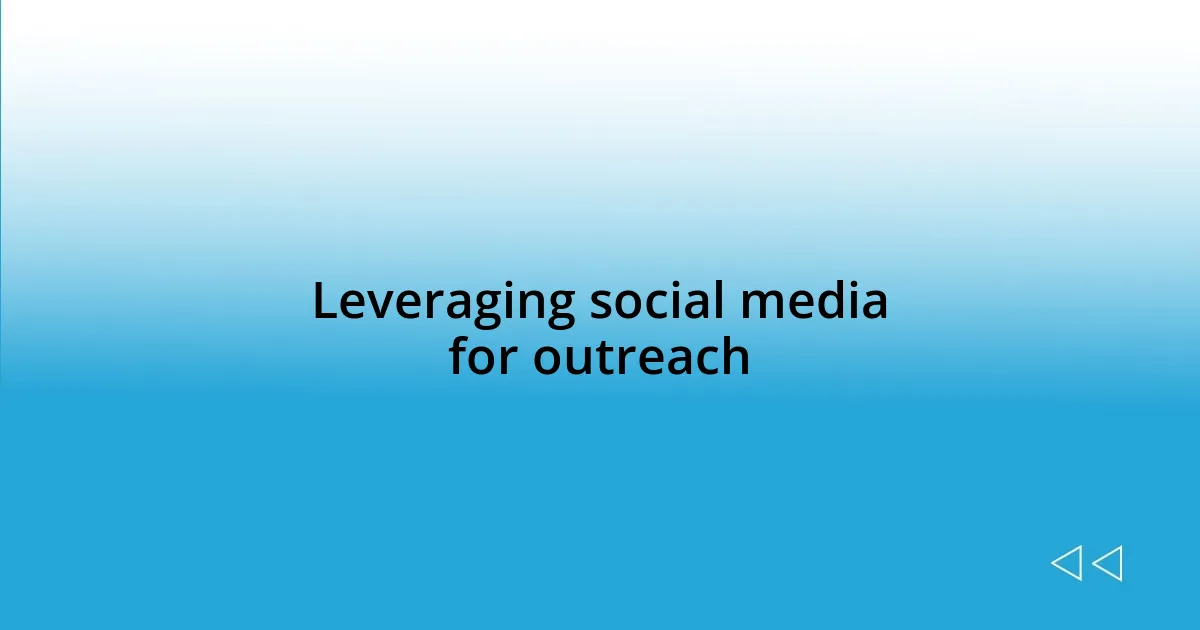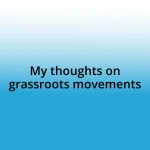Key takeaways:
- Understanding the audience and tailoring content to evoke emotional responses is crucial for effective online activism.
- Selecting the right platform enhances outreach and engagement, as different platforms serve varied content formats and interaction styles.
- Building an engaged online community fosters meaningful connections; sharing personal stories encourages participation and collaboration.
- Measuring impact through community feedback and engagement metrics helps validate activism efforts and shapes future strategies.

Understanding online activism strategies
When I first dove into online activism, I quickly realized that understanding my audience was crucial. It wasn’t enough to just share my passion; I had to think about who would resonate with my message. Have you ever posted something that fell flat? That’s a common frustration, but it taught me the importance of tailoring content to evoke emotional responses and spur action.
Choosing the right platform can also make a world of difference in online activism. For example, I found that visuals shared on Instagram had a different impact than detailed articles posted on Medium. It’s fascinating how a single image can ignite passion or spark a debate, isn’t it? I once shared a powerful graphic about climate change that reached thousands, while a thought-provoking article on the same issue barely got noticed. This experience reinforced my understanding of platform dynamics.
Engagement is another key strategy I learned through trial and error. Simply broadcasting a message doesn’t yield results; I needed to foster conversation and build a community. I remember hosting a live Q&A session where I answered questions about mental health advocacy. The outpouring of support and shared stories was overwhelming and reminded me of the collective power of our voices. Have you ever felt that buzz of connection when discussing something you care about? It’s those moments that illuminate the true power of activism.

Choosing the right platforms
Selecting the right platforms for activism is pivotal for reaching your goals effectively. I remember the first time I faced a choice between Twitter and Facebook for promoting a local environmental campaign. While Twitter allowed for rapid updates and engagement, Facebook’s group features fostered deeper conversations. This taught me that understanding the unique strengths of each platform can shape the outcome of your message’s reach.
Here’s a breakdown of considerations to keep in mind:
- Demographics: Know who your audience is using each platform.
- Content Format: Different platforms excel with varied content, like visuals on Instagram versus articles on Medium.
- Engagement Style: Consider how you want to interact—quick responses on Twitter or longer discussions on forum-like spaces.
- Trend Awareness: Be aware of emerging platforms; what’s popular today may significantly shift.
- Personal Comfort: Utilize platforms where you feel confident and enjoy participating, as it will reflect in your advocacy.

Building an engaged online community
Building an engaged online community has been one of the most rewarding aspects of my activism journey. I remember launching a campaign on Instagram aimed at promoting mental health awareness. By sharing personal stories and inviting followers to do the same, I witnessed a beautiful exchange of support and encouragement. It highlighted to me that creating a space where people feel comfortable sharing their experiences can transform a simple online presence into a vibrant community. Isn’t it incredible how just a few genuine connections can spark a much larger conversation?
Creating content that resonates is vital, but it’s also important to engage meaningfully. I once initiated a monthly challenge on social media where followers could post their reflections on activism topics. Each month, I genuinely committed to commenting on every post, which not only fostered connection but also encouraged deeper discussions. I found that people were more likely to stay engaged when they felt appreciated and heard. Reflecting on that, I can’t help but wonder: have you ever felt more involved in something when your opinion was valued?
To make online communities flourish, it’s essential to encourage collaboration. During a recent campaign on climate action, I invited fellow activists to co-host an online workshop. Together, we created a dynamic environment where everyone shared their knowledge, experiences, and strategies. The response was incredible, as participants left feeling empowered and eager to contribute further. It’s a poignant reminder that activism often thrives in collective spaces, don’t you think?
| Aspect | Importance |
|---|---|
| Personal Engagement | Fosters connection and trust |
| Meaningful Content | Drives discussion and interest |
| Collaboration | Encourages shared ownership of goals |

Creating impactful content for change
Creating impactful content for change is all about tapping into what resonates with your audience. I recall a time when I crafted a video highlighting local impact stories concerning pollution. Instead of just throwing facts at viewers, I featured interviews with community members who shared their struggles and hopes. The emotional connection that formed was evident in the comments, where people didn’t just engage—they felt seen and heard. Isn’t it amazing how personal stories can bridge the gap between information and genuine understanding?
Another key element in my experience has been the power of visuals. During a campaign for social justice, I used infographics to simplify complex statistics that can often feel overwhelming. One graphic, which illustrated the disparity in police encounters based on demographics, sparked countless discussions. I found that when data is presented in a relatable way, it not only informs but also motivates action. How many times have you been moved to engage simply by seeing something visually compelling?
I’ve learned that consistency in messaging is crucial. I remember running a series of posts over several weeks about sustainable practices, each one building on the last. This approach deepened understanding and kept followers excited about what would come next. It’s like telling a story—each chapter needs to connect, creating a narrative that keeps people coming back for more. Have you ever followed a series of content that left you eager to see what would happen next? That’s the magic of creating a cohesive message for meaningful change.

Leveraging social media for outreach
When I think about leveraging social media for outreach, I can’t help but recall a particular Twitter campaign I launched during a time of social upheaval. Engaging directly with trending hashtags allowed my voice to be heard amid the noise. I shared not just my thoughts but also curated resources that could help others take meaningful action. It was eye-opening to see how quickly a single tweet could mobilize a community, with people sharing the information far beyond my original network. Isn’t it refreshing when something as simple as a tweet can create such a ripple effect?
One memorable experience was hosting a live Q&A session on Facebook to discuss pressing issues in our community. I encouraged followers to submit their questions ahead of time and during the session, I answered as many as I could. Watching the engagement in real-time was exhilarating! It gave me a chance to connect with individuals personally, and I felt their eagerness for dialogue. This interactive format not only built trust but also revealed how much people appreciate having a platform for their voices. Have you ever felt more connected when participating in a conversation rather than just absorbing information passively?
In addition to one-off events, I’ve learned that building a consistent schedule for posts can be powerful for outreach. For instance, I created a weekly series featuring individuals making a positive impact in our community. By highlighting their achievements, I not only brought attention to their work but also inspired others by showcasing relatable role models. The more I shared these stories, the more my audience engaged. It turns out that seeing familiar faces making a difference was more motivating than I had anticipated. Don’t you find it inspiring to see people you can relate to stepping up for change?

Measuring the impact of activism
When measuring the impact of activism, I often reflect on the tangible changes brought about by my initiatives. I vividly remember a campaign where we pushed for better recycling practices in our neighborhood. After a month of advocacy, local officials reported a 30% increase in recycling rates. To me, that number was more than just a statistic; it represented a shift in community values. Isn’t it rewarding when your efforts translate into real-world results?
Another aspect I’ve found crucial is feedback from the community. After conducting a survey following a major event, I was thrilled—and a bit surprised—to discover that 85% of participants felt more empowered to act on environmental issues. The responses not only validated my work but highlighted the importance of listening to those I aimed to help. Have you ever sought feedback and found insights that reshaped your approach? It reminds me how activism is as much about community as it is about messaging.
Analyzing engagement metrics on social media has also offered valuable insights. I recall the day I posted a simple call to action, asking followers to share their stories related to climate change. The post did unexpectedly well; it received hundreds of shares and sparked a marathon of conversations. Those numbers told me that my audience was ready and willing to engage on deeper levels. What if a single post could unlock a whole dialogue? It’s a potent reminder of how social media can serve as a thriving forum for change.

Adapting tactics for better engagement
Adapting my tactics for better engagement has been a game-changer in my activism efforts. For example, I once decided to shift from informative posts to storytelling, sharing personal experiences related to the struggles I was highlighting. The response was incredible; people opened up about their own journeys, and it felt like I had unlocked a vault of shared emotions. Isn’t it amazing how vulnerability can create genuine connections?
During another initiative, I experimented with interactive polls on Instagram to gauge my audience’s opinions on various social issues. The results were revealing and, honestly, a bit humbling. I learned not only what issues mattered most to my community but also that they valued having a say in shaping our discussions. Have you ever felt empowered just by expressing your opinion in a simple poll? It reminded me that fostering dialogue can be as significant as advocacy itself.
I’ve also recognized the power of adapting my messaging style to be more inclusive. After attending a workshop on accessibility, I began using plain language and providing context for any jargon I might include. The feedback was heartwarming—someone even told me they felt seen because the information was now understandable to them. Isn’t it rewarding when people acknowledge their voices matter, and they don’t have to decode what you’re trying to say? Making adjustments like this not only expanded my reach but deepened my sense of connection within the community.
















